Overview
This article highlights a relatable challenge that many startups face: effectively engaging their audience. In a competitive landscape, the struggle to capture attention and drive user interaction can feel overwhelming. It’s not just about having a great product; it’s about how you communicate that value to potential customers.
The implications of this struggle are significant. Without strong engagement, startups may find it difficult to convert leads into loyal customers, which can hinder growth and sustainability. It’s a pain point that many founders experience, often feeling isolated in their efforts to make meaningful connections with their audience.
However, there is hope. The article provides nine powerful examples of calls to action (CTAs) that can significantly enhance engagement. These CTAs are not just generic prompts; they are tailored, urgent, and strategically placed to resonate with users. Supported by statistics and successful case studies from renowned companies like Nike, Airbnb, and Chipotle, these examples illustrate the transformative power of effective CTAs in driving user interaction and conversion rates.
As you read through these examples, consider how they might apply to your own startup. Have you experimented with different CTAs? What has worked for you? Sharing your experiences can foster a sense of community and support among fellow founders navigating similar challenges.
By implementing these strategies, you can create a more engaging experience for your users, ultimately leading to higher conversion rates. Remember, you’re not alone in this journey. Embracing the right tools and insights can make a world of difference for your startup.
Introduction
In a landscape where tech startups strive for visibility, the challenge of crafting compelling calls to action (CTAs) can often feel overwhelming. Founders frequently find themselves wrestling with how to genuinely connect with their audience and inspire immediate engagement, a crucial factor for both growth and success. This article explores nine powerful examples of CTAs that not only captivate potential customers but also drive significant interaction. Here, we offer insights into innovative strategies that can enhance startup engagement.
How can startups harness these effective CTAs to transform casual interest into active participation and foster lasting relationships?
RNO1: Innovative CTAs for Enhanced Digital Engagement
In the fast-paced world of tech startups, one common challenge is crafting ctas examples that truly resonate with audiences. Many founders struggle to capture attention and prompt meaningful engagement. This is where RNO1 shines, utilizing innovative ctas examples that emphasize clarity and urgency, such as their compelling phrase, 'Join the Revolution.' Such phrases not only grab attention but also inspire immediate involvement, addressing a critical need for connection in a crowded marketplace.
Research shows that ctas examples can outperform basic calls to action by an impressive 202%. This statistic underscores the importance of tailoring messages to meet individual needs, a principle that RNO1 embraces wholeheartedly. By seamlessly integrating these persuasive ctas examples into their digital experiences, RNO1 not only enhances user engagement but also significantly boosts conversions, reinforcing their reputation as a leader in the branding arena.
Moreover, it’s worth noting that calls to action placed above the fold can outperform those positioned below by a staggering 304%. This highlights the strategic placement of RNO1's prompts, ensuring they are seen and acted upon. Their commitment to effective CTA strategies nurtures enduring connections between brands and their audiences, fostering a sense of community.
At RNO1, the focus is on creating a supportive environment where tech startup founders can thrive. By addressing the pain points of engagement with empathy and understanding, RNO1 offers solutions that not only enhance involvement but also cultivate lasting relationships. This dedication to nurturing connections is what sets RNO1 apart and empowers founders to succeed.
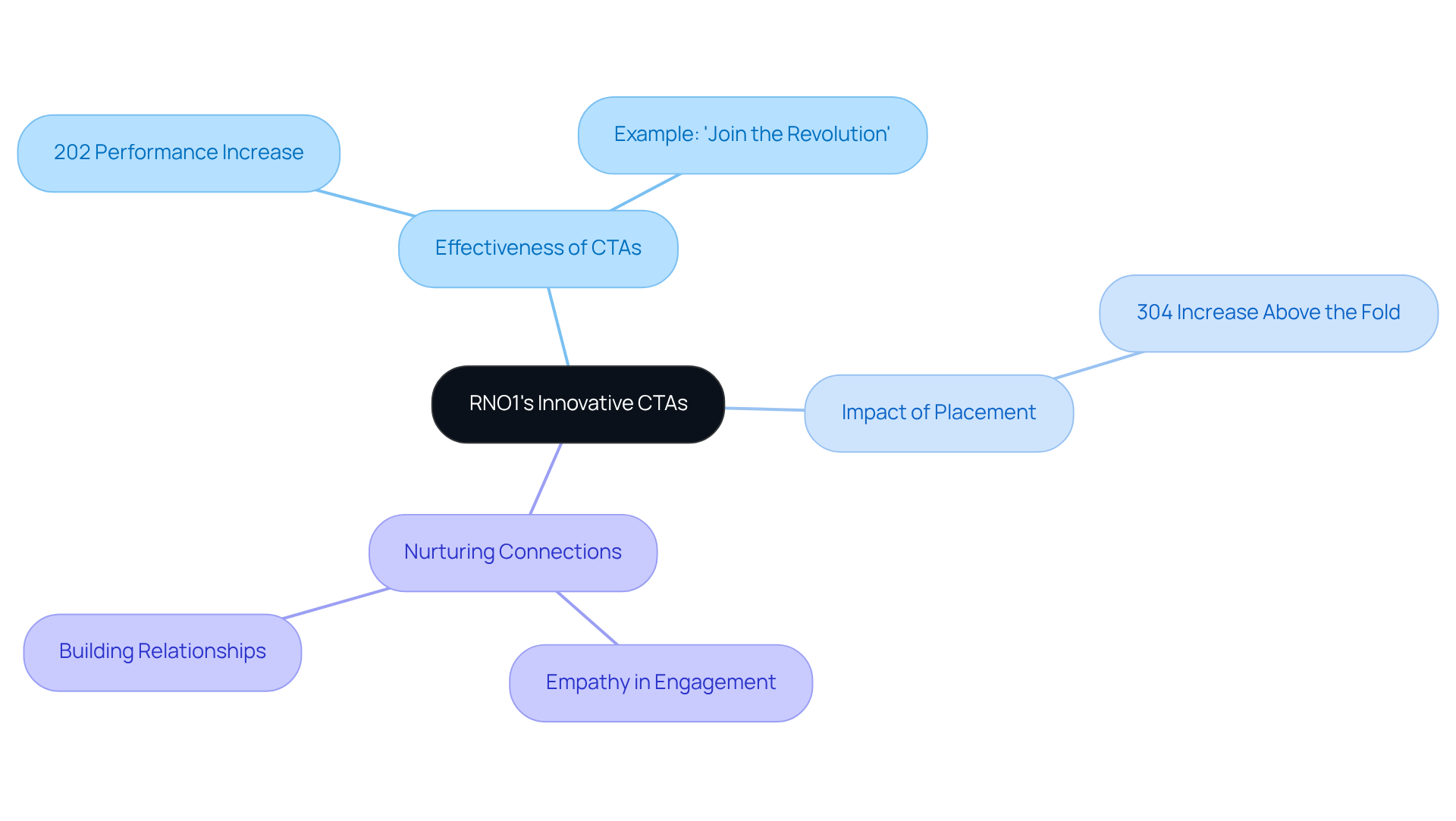
HubSpot: 49 Call-to-Action Examples You Can't Help But Click
Many startups struggle to engage potential customers effectively, and this challenge can feel overwhelming. You might find yourself wondering how to prompt immediate action from your audience. HubSpot's compilation of 49 persuasive CTAs examples can provide the insights you need. Phrases such as 'Get Your Free Trial' and 'Download Now' are designed to create a sense of urgency, encouraging users to act quickly.
These calls to action not only facilitate the purchasing process but also resonate with users' desire for value and exclusivity. As we move into 2025, the importance of urgency in calls to action will only grow. Strategies that incorporate time-sensitive offers and clear, action-oriented language will become essential. For example, using urgency words like 'now' or 'limited time' can boost conversion rates by an impressive 14%. This highlights the necessity for startups to embrace these tactics.
Real-world CTAs examples show that integrating calls to action into video content can lead to a remarkable 380% increase in conversions. This clearly illustrates the powerful role urgency plays in enhancing engagement. Additionally, personalized calls to action can convert 202% better than basic ones, underscoring the importance of customization in urgency-driven strategies.
By understanding and applying these trends, you can develop CTAs examples that not only capture attention but also transform interest into meaningful engagement. Remember, you are not alone in this journey; many have faced similar challenges and found success by implementing these strategies.
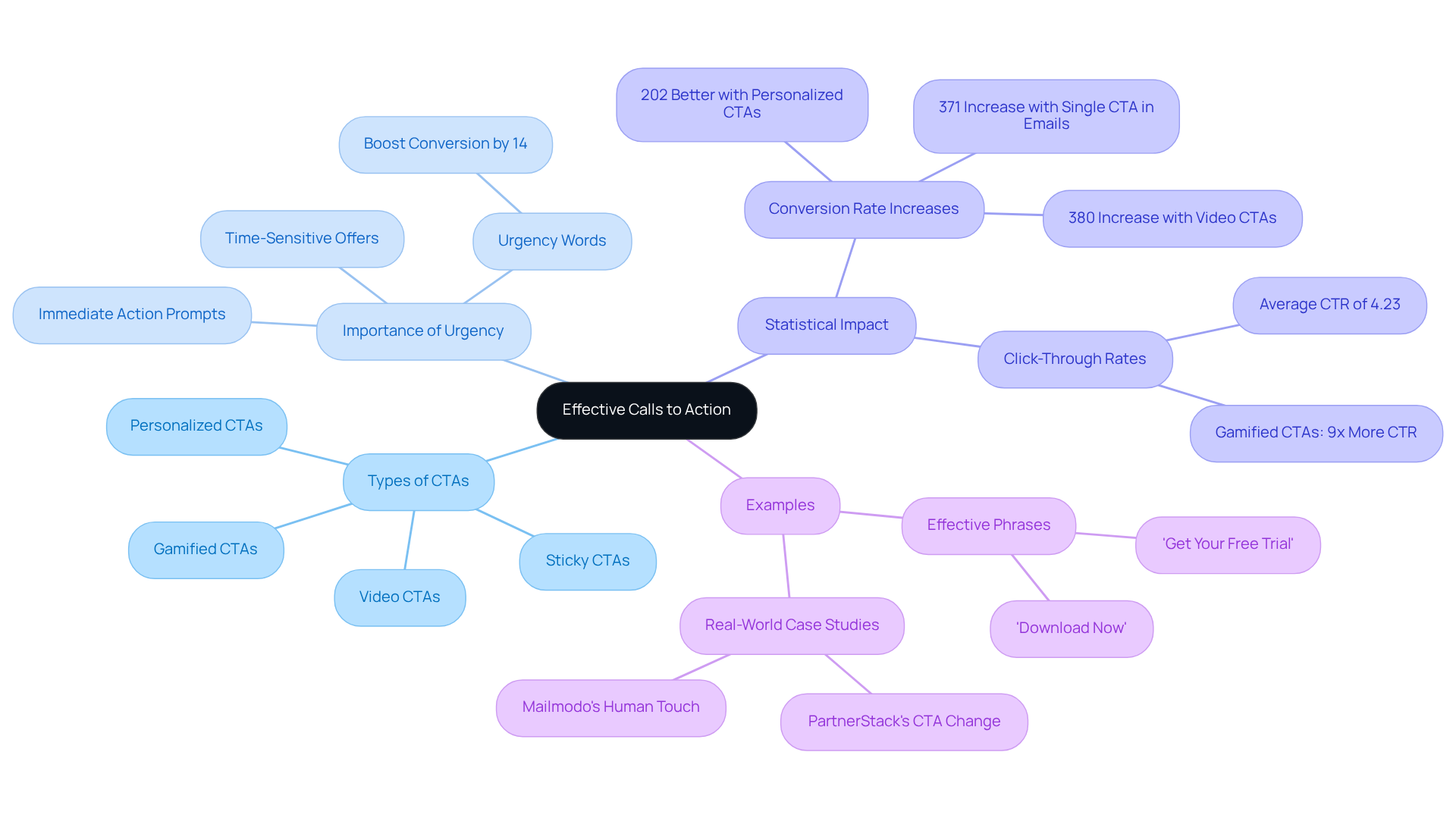
KlientBoost: Psychology of a Call-to-Action Button
Many tech startup founders struggle with crafting calls to action, often looking for ctas examples that truly resonate with their audience. This challenge can lead to missed opportunities, as potential customers may overlook important prompts that could guide them toward making a decision. The psychological aspects of call-to-actions are often underestimated, yet they play a crucial role in user behavior.
Consider how elements like color, placement, and wording can significantly influence engagement. For instance, using contrasting colors for buttons can draw attention, making them stand out on the page. Additionally, imperative verbs such as 'Discover' or 'Claim' can evoke a sense of urgency, compelling users to act. These small, yet impactful choices can transform a simple prompt into a powerful motivator.
By understanding these psychological triggers, startups can develop ctas examples that not only attract clicks but also convert leads into loyal customers. It’s about more than just aesthetics; it’s about connecting with your audience on a deeper level. Embracing these strategies can help you foster a more engaging and supportive experience for your users, ultimately leading to greater success for your startup.
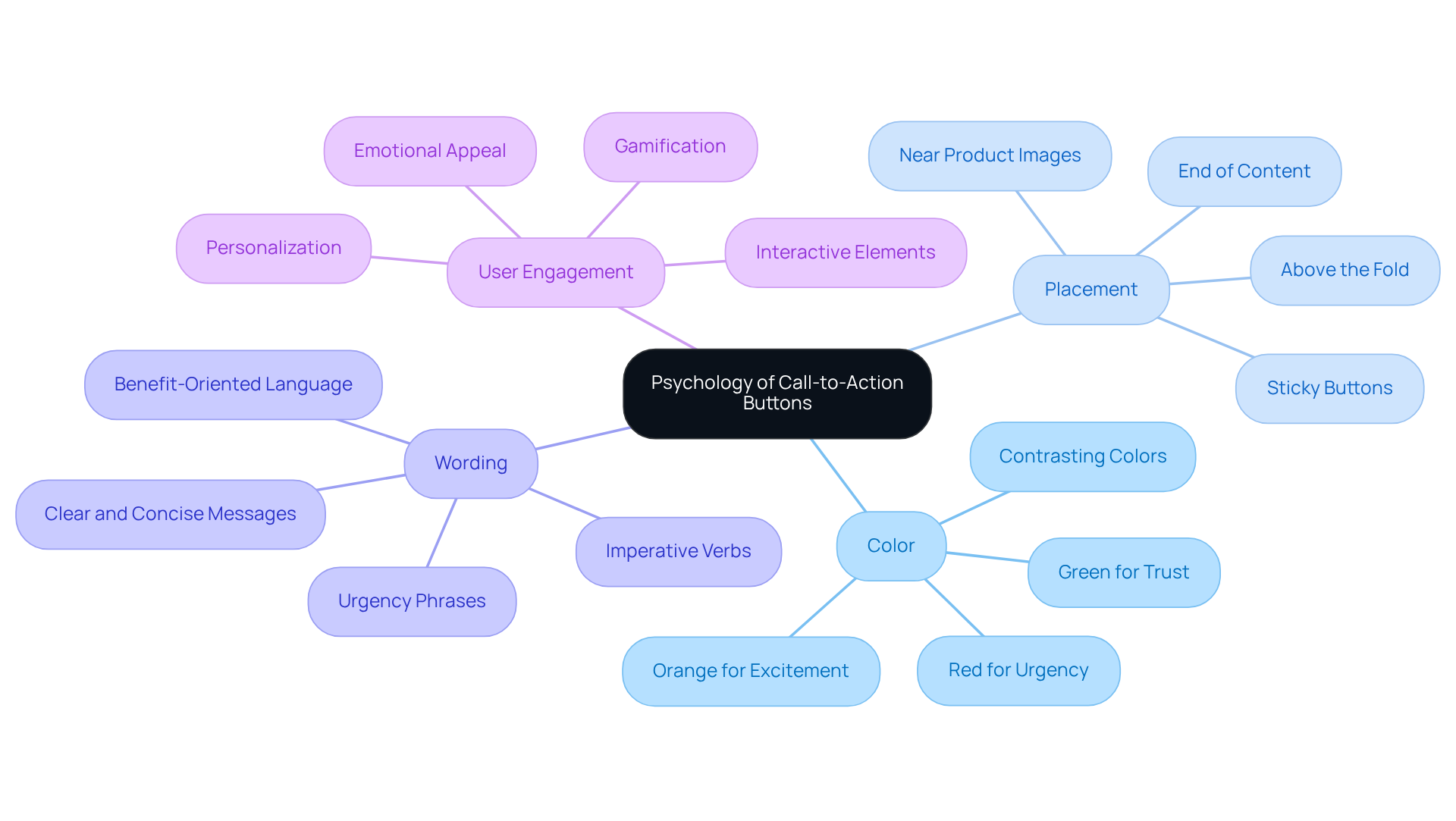
Nike: Bold CTAs That Inspire Action
Nike's legendary ctas example, such as 'Just Do It,' illustrates a common challenge many startups face: how to create messaging that truly resonates. It's not just about words; it's about motivating a prompt response. When we think about how impactful messaging can empower us, it becomes clear that the right language fosters deeper engagement with a brand. As startup founders, you can draw valuable lessons from Nike’s approach. Imagine creating ctas examples that not only encourage engagement but also align with your core values and mission.
Consider this: calls to action that employ action-oriented language can increase conversions by as much as 121%. That’s a significant boost! Additionally, using first-person phrasing can improve conversions by 90%. These statistics highlight the importance of connecting with your audience on a personal level. Urgency also plays a crucial role—phrases like 'Act Now' can elevate conversion rates by 14%. It’s about creating a sense of immediacy that encourages your audience to take action.
Furthermore, positioning calls to action after testimonials can enhance trust and conversions by 25%. This strategic placement underscores the significance of building credibility with your audience. By focusing on developing ctas examples that reflect your unique identity, you can foster stronger connections. Personalization is key; it performs 202% better than standard calls to action, reinforcing the idea that your audience wants to feel valued and understood.
In this journey, remember that you're not alone. By embracing these strategies, you can promote meaningful engagement with your audience, nurturing a community that supports your mission.
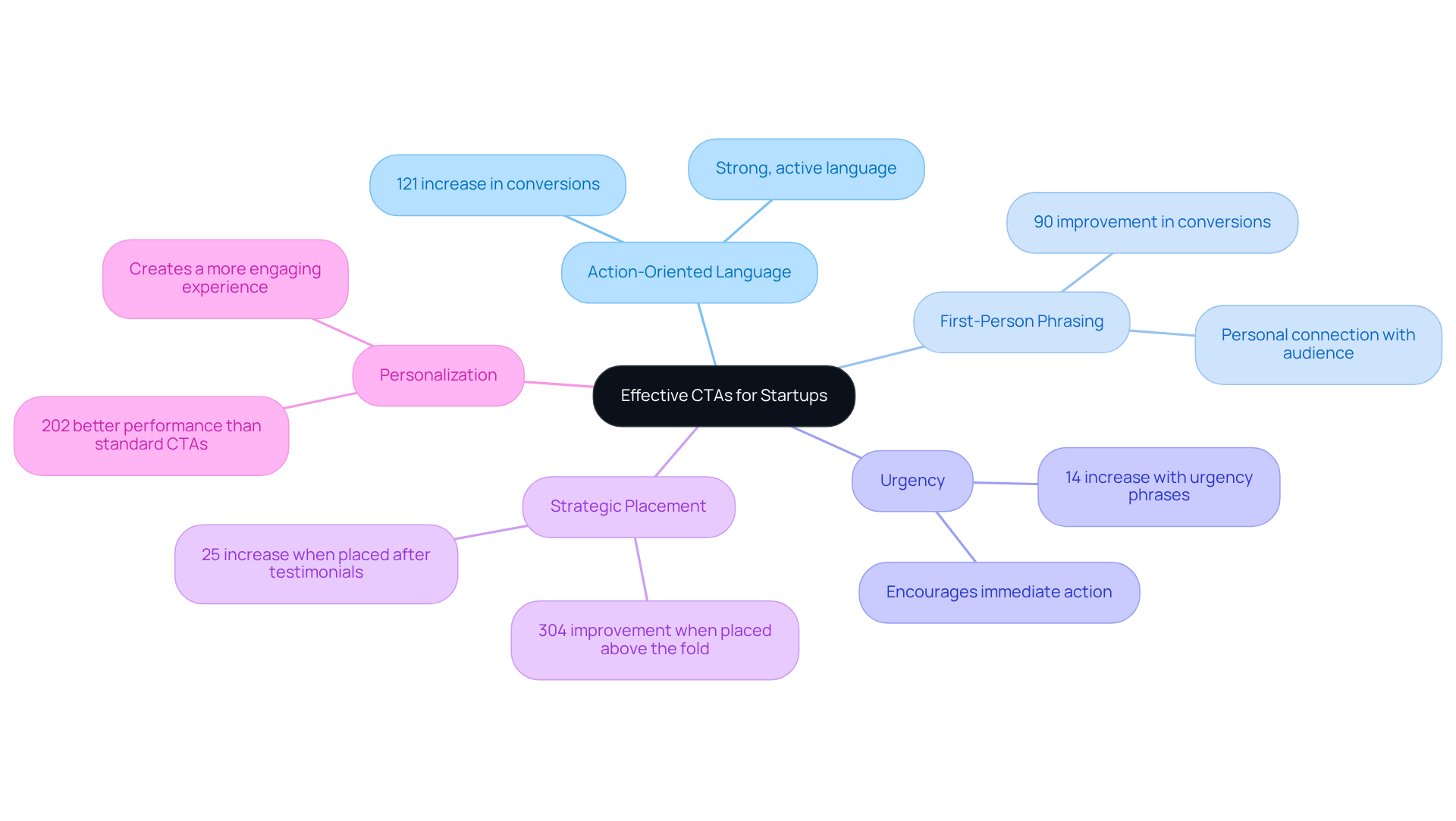
Airbnb: Creative CTAs That Drive Bookings
Airbnb faces the common challenge of attracting customers in a competitive market. They creatively address this issue with imaginative CTAs examples like 'Find a Place to Stay' and 'Book Your Adventure.' These phrases not only guide individuals but also ignite a sense of exploration and adventure. By using engaging language, Airbnb captures the spirit of travel, encouraging people to take that important step forward.
In a targeted campaign in Japan, Airbnb focused on domestic travelers with Japanese-language ads that celebrated local experiences. This thoughtful approach led to a remarkable increase in first-time bookers and boosted brand awareness significantly. As Thibault Masson, Head of Product Marketing at PriceLabs, insightfully pointed out, this campaign illustrates Airbnb's broader strategy to shift guest mindsets beyond just seeking homes, highlighting the importance of meaningful experiences.
Startups can draw inspiration from this approach. By infusing creativity into their CTAs example, they can enhance their appeal and engagement with potential customers. It's about nurturing connections and fostering a sense of community, which can resonate deeply with audiences. Remember, it’s not just about what you offer; it’s about how you invite others to join you on the journey.
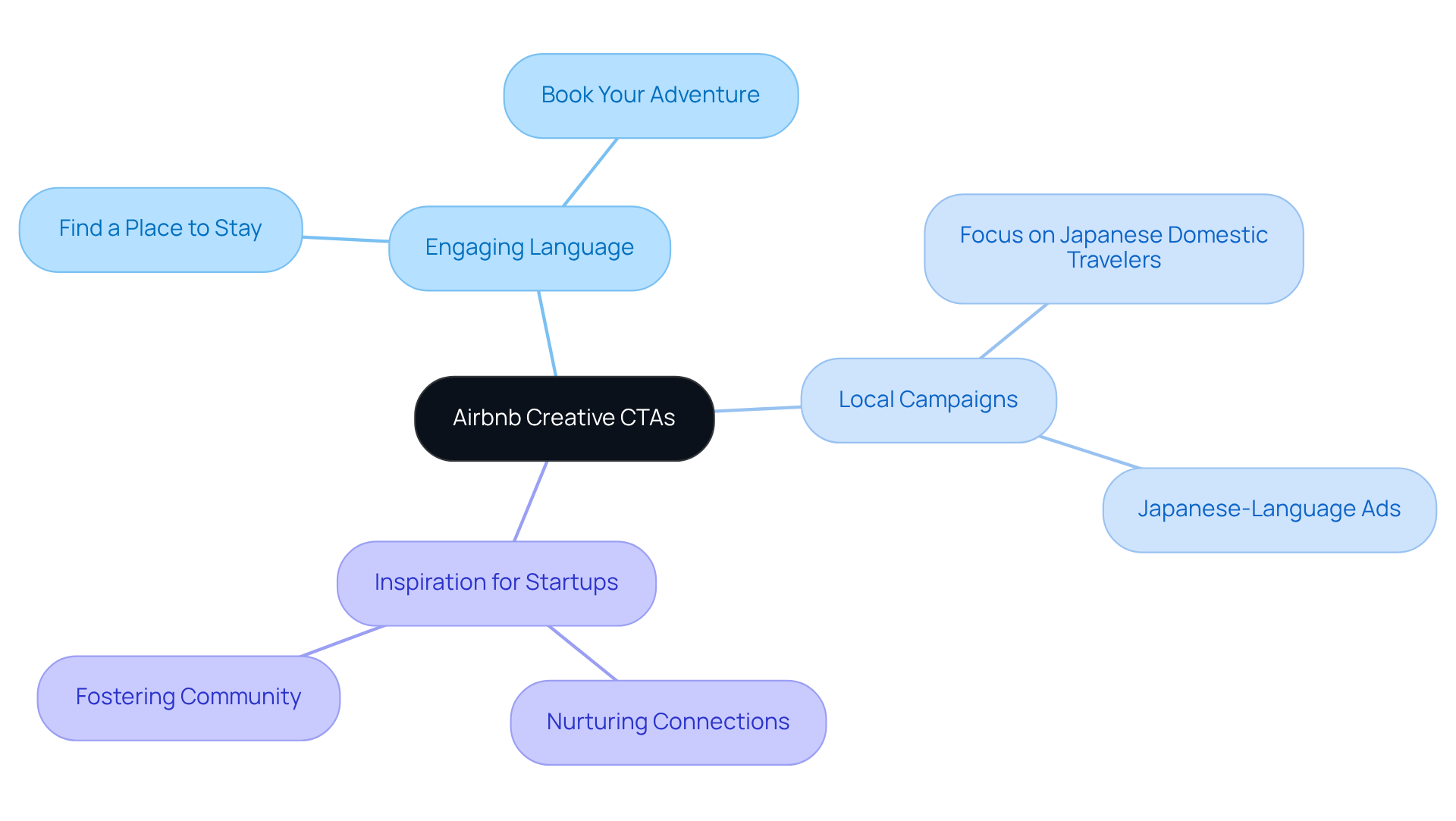
Figma: Engaging CTAs for Design Collaboration
In today's fast-paced digital world, many tech startup founders face the challenge of fostering collaboration and engagement within their teams. This can often lead to feelings of isolation and frustration, as the lack of interaction stifles creativity and innovation. Figma's CTAs example, including 'Start Designing' and 'Invite Your Team,' serve as a beacon of hope, strategically crafted to promote collaboration and boost engagement. By encouraging individuals to take prompt steps, these appeals not only enhance the overall experience but also nurture a lively community among participants.
For instance, calls to action that invite team members can significantly enhance interaction. It's noteworthy that personalized prompts convert 202% better than standard ones, illustrating the power of tailored communication. Startups can draw valuable lessons from Figma's approach by creating CTAs examples that drive activity while also encouraging collaboration and interaction. This ultimately leads to a more engaged user base, which is essential in today’s digital landscape where effective collaboration tools can enhance productivity and innovation.
At RNO1, we exemplify this results-driven approach, ensuring that every CTAs example acts as a strategic element contributing to measurable success. We focus on clear communication and collaborative project management while preventing scope creep. Our commitment to nurturing a supportive environment allows founders to feel empowered and connected.
Moreover, CTAs examples can take various forms—buttons, banners, or links—each designed to facilitate collaboration in digital products. By sharing your experiences and insights, we can collectively create a more engaging and supportive community for all tech startup founders. Together, let’s embrace the power of collaboration and transform our challenges into opportunities for growth.
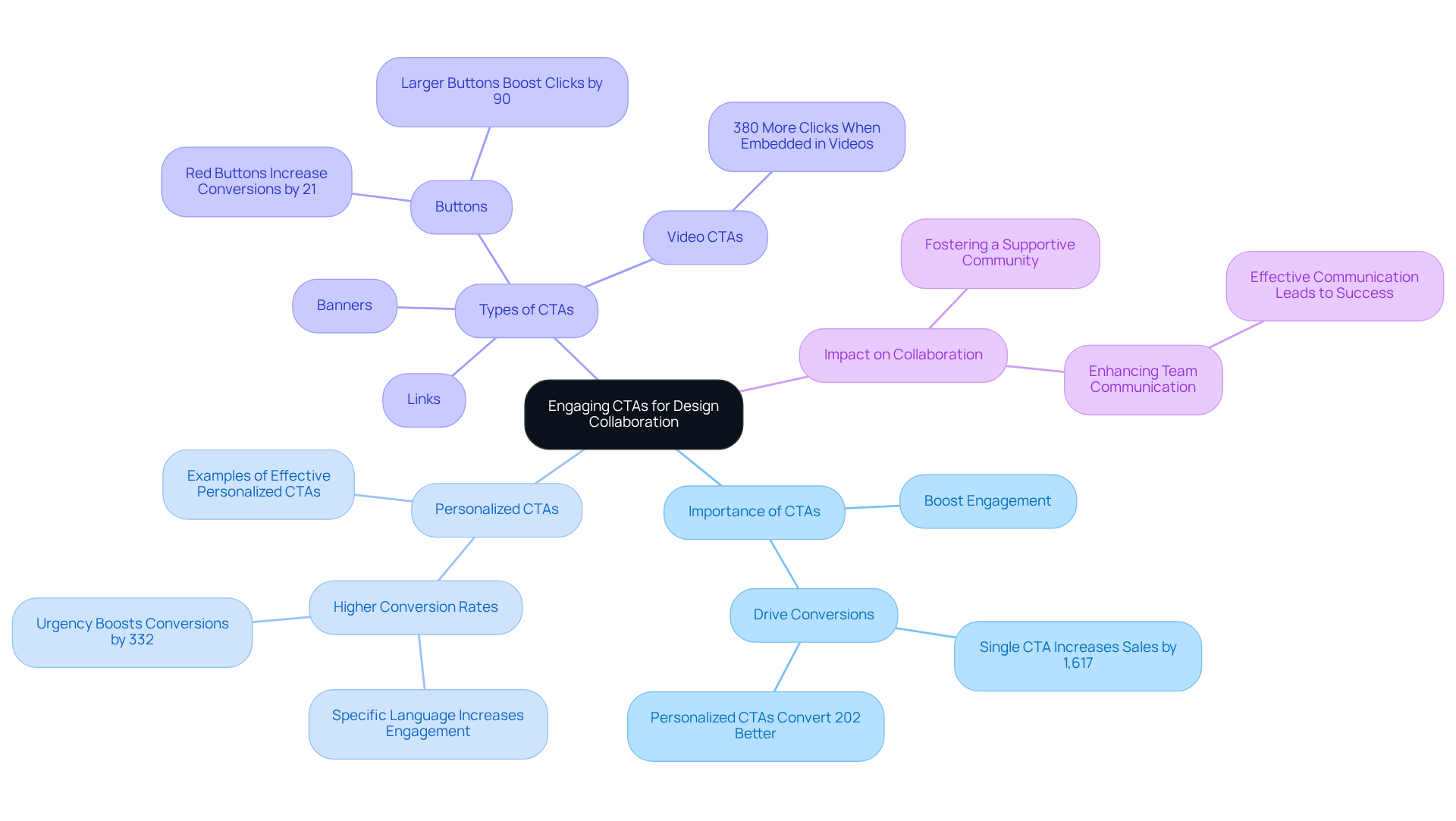
Netflix: Compelling CTAs That Keep Viewers Watching
Many startup founders grapple with the challenge of keeping users engaged. It's disheartening to see potential customers drift away, leaving behind a trail of incomplete interactions. This is a common pain point that can lead to frustration and uncertainty about the future of their business.
Consider how Netflix effectively employs CTAs examples, such as 'Continue Watching' and 'Watch Next Episode.' These gentle nudges serve not just as reminders but as a way to reconnect viewers with their habits, significantly boosting retention rates. Startups can adopt similar CTAs examples to improve user engagement. By integrating calls to action that encourage users to continue interacting with their content—such as reminders for incomplete tasks or suggestions for related content—founders can create a more inviting atmosphere for participation.
RNO1's Ryde initiative exemplifies the power of robust omnichannel engagement strategies. By incorporating user-generated content programs and influencer onboarding, they have successfully enhanced community engagement and marketing efforts. Imagine how adopting these compelling CTAs examples and innovative strategies could transform your startup.
By nurturing these connections and fostering a more immersive user experience, founders can not only improve retention but also cultivate a sense of satisfaction among their users. Remember, you’re not alone in this journey; by sharing these experiences and strategies, we can build a supportive community that thrives together.
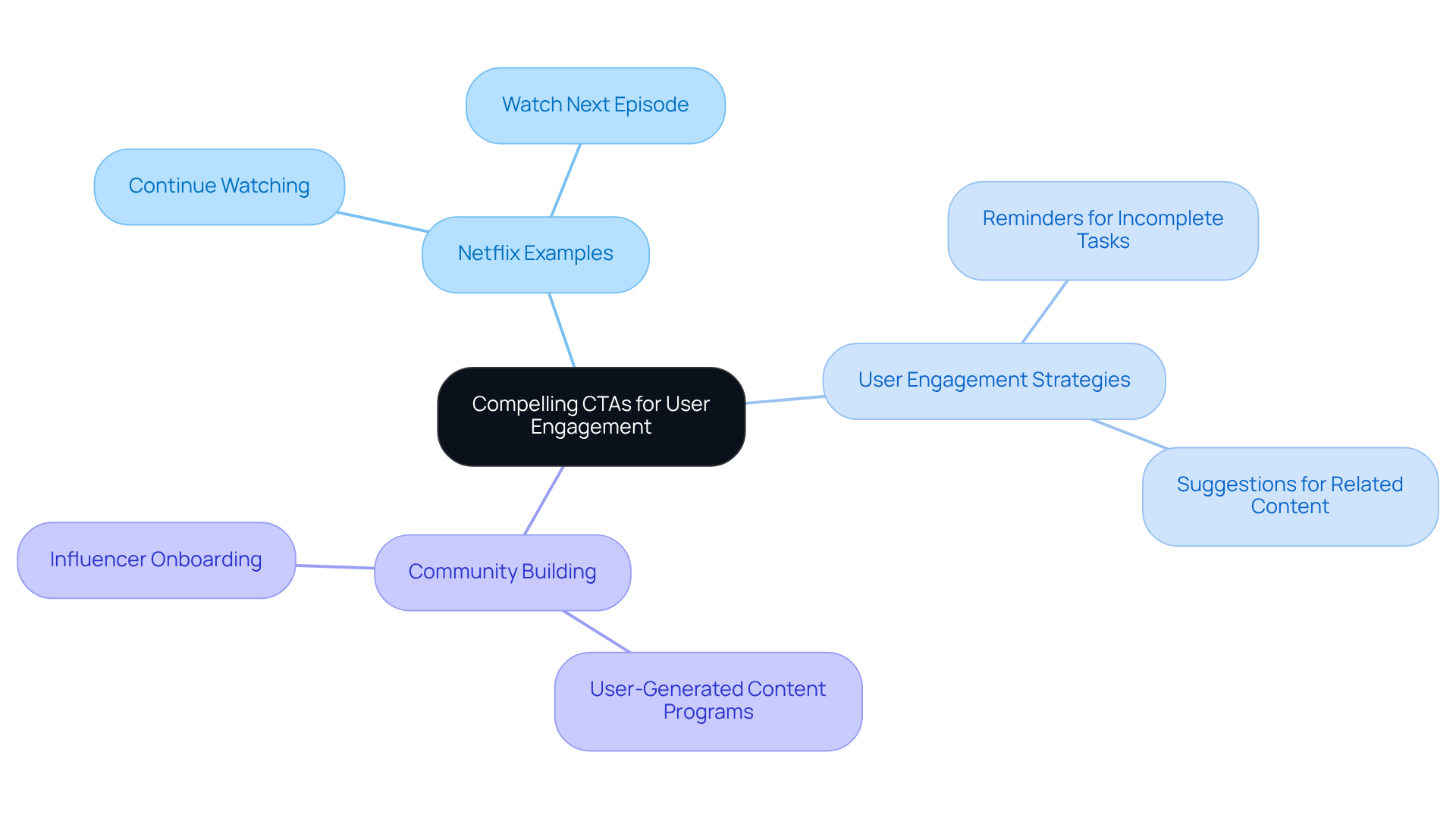
Chipotle: Delicious CTAs That Boost Online Orders
In the competitive landscape of the food industry, many startups struggle to capture customer attention and drive engagement. This challenge can feel overwhelming, especially when trying to stand out in a crowded market. However, Chipotle provides a compelling ctas example of how to effectively engage customers through enticing calls to action like 'Order Now' and 'Customize Your Bowl.' By employing clear and appealing language, Chipotle not only drives online orders but also significantly enhances customer interaction.
Statistics reveal that calls to action featuring dynamic words can increase conversions by as much as 20%. This underscores the importance of using inviting language to encourage prompt responses. Furthermore, customized calls to action convert 202% more effectively than standard ones, highlighting the value of tailoring messages to meet personal preferences. For startups in the food industry, Chipotle's approach is a valuable ctas example from which important lessons can be learned. Creating calls to action that evoke desire and urgency can lead to improved customer engagement and positively influence buying choices.
Incorporating urgency terms can further enhance conversions by 14%, making it essential for startups to consider language that prompts a response. A/B testing of calls to action, which can improve performance by an average of 28%, offers additional insights into optimizing these prompts. By focusing on appetizing language, startups can enhance customer engagement and drive sales, ultimately fostering a deeper connection with their audience. Together, let’s explore how these strategies can help you navigate the challenges of engaging your customers effectively.
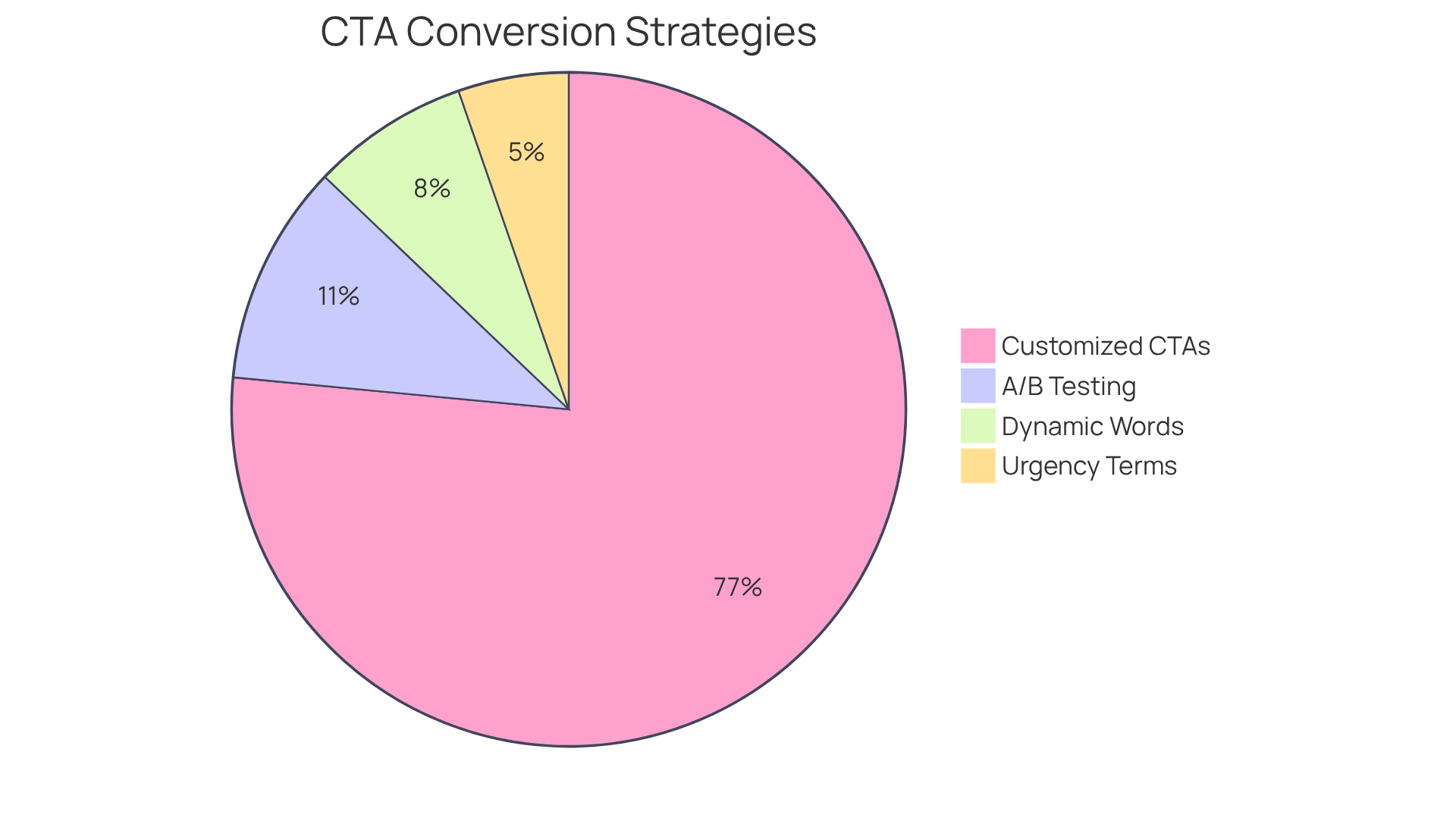
Shopify: Effective CTAs for eCommerce Success
Navigating the world of eCommerce can be challenging, especially for tech startup founders striving to optimize their user engagement. One common hurdle is the effectiveness of CTAs examples like 'Add to Cart' and 'Start Your Free Trial.' These elements are not just mere buttons; they are pivotal in shaping the purchasing journey and encouraging user sign-ups. When strategically placed, CTAs examples can significantly impact conversion rates, with those positioned above the fold enhancing engagement by an impressive 84%. An example of CTAs is that tailored CTAs can even outperform standard ones by a remarkable 202%.
However, the reality is that many startups struggle to harness this potential. The absence of clear, actionable CTAs examples can result in missed opportunities and frustrated users. Adding urgency to these CTAs examples can increase conversions by 14%, making them more persuasive and effective. With only 30% of B2B websites utilizing a CTA, there lies a vast opportunity for startups to refine their engagement strategies.
A/B testing different CTAs examples is crucial for improving performance. By analyzing consumer behavior, companies can adapt their strategies to better meet the needs of their audience. This iterative process not only enhances the overall shopping experience but also drives eCommerce success, as shown by CTAs examples on landing pages that can boost conversion rates by an astonishing 111-306%.
Consider the innovative strategies employed by RNO1 in the Cirkul case study; they are a prime CTAs example of how effective CTAs can capture user attention and facilitate seamless transactions in a competitive online marketplace. For tech startup founders, the path to success lies in experimenting with different CTAs examples and their placements and wording. By finding what resonates best with your audience, you can create a nurturing environment that encourages engagement and fosters growth. Remember, you are not alone in this journey—embracing these strategies can lead to a brighter, more successful future for your startup.
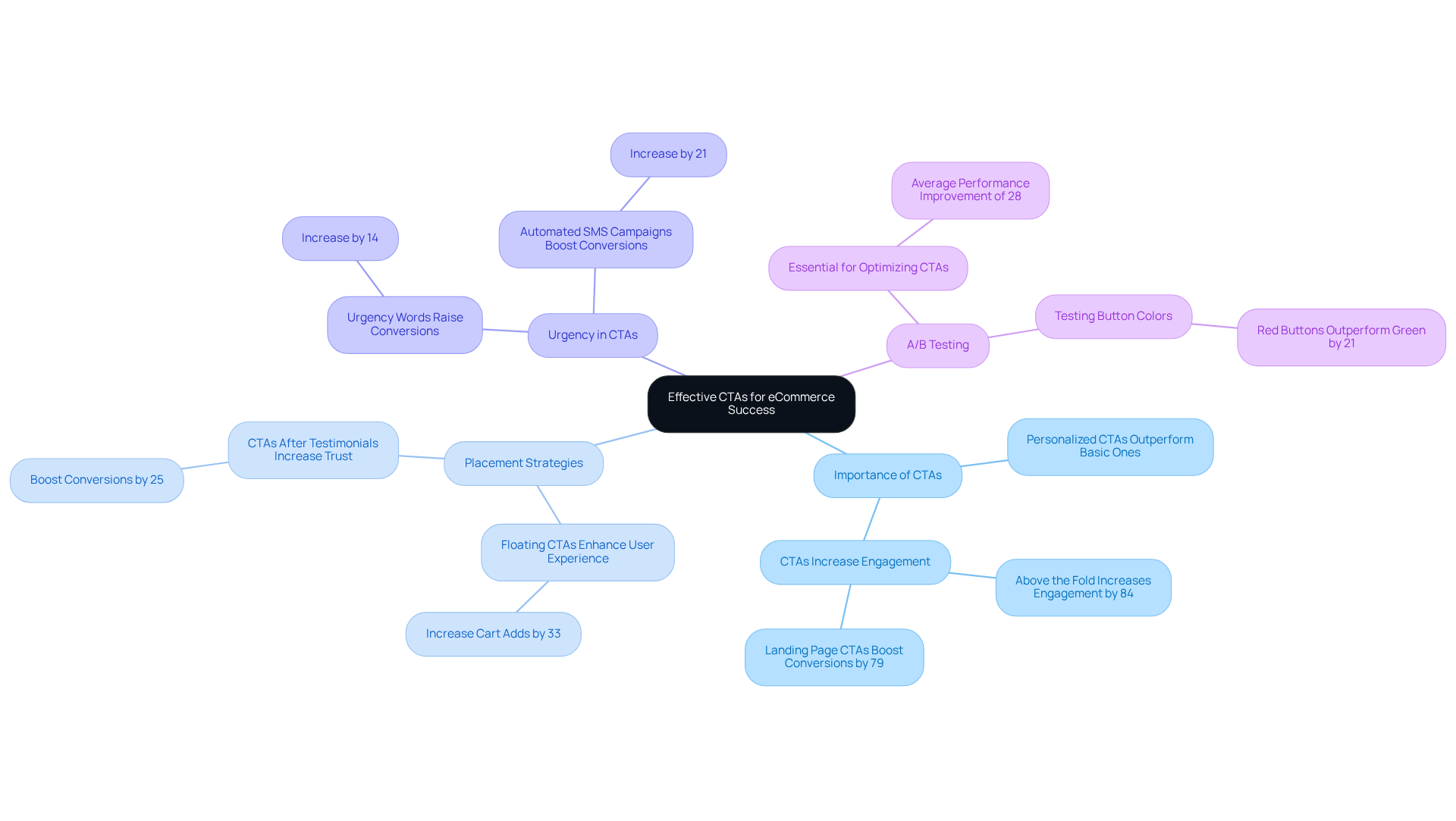
Conclusion
Crafting effective calls to action (CTAs) can feel overwhelming for startups striving to enhance user engagement and drive conversions. It’s a challenge many face, and understanding the psychological triggers that motivate users is crucial. Startups can create impactful CTAs that truly resonate with their audience by utilizing innovative strategies. The examples provided from industry leaders serve as a beacon of hope, demonstrating how powerful messaging and strategic placement can significantly boost engagement and foster lasting connections.
Throughout this article, we’ve shared key insights, highlighting the importance of urgency in CTAs, the effectiveness of personalized messaging, and the role of clear communication in driving user action. From RNO1's compelling phrases to HubSpot's extensive collection of examples, each case illustrates the necessity of tailoring CTAs to meet the specific needs and preferences of potential customers. Moreover, integrating creativity and action-oriented language, as seen with brands like Nike and Airbnb, can inspire immediate responses and enhance brand loyalty.
Ultimately, embracing these strategies is vital for startups navigating the competitive landscape. Experimenting with various CTA designs and placements, leveraging psychological insights, and fostering a sense of community can transform engagement efforts. The journey toward meaningful user interactions is ongoing. By implementing these proven tactics, startups can cultivate deeper connections that lead to sustained growth and success. Remember, you are not alone in this journey; together, we can build a supportive community that thrives.
Frequently Asked Questions
What are CTAs and why are they important for tech startups?
CTAs, or calls to action, are prompts designed to encourage immediate engagement from audiences. They are crucial for tech startups as they help capture attention, prompt meaningful actions, and enhance user engagement, ultimately boosting conversions.
How can innovative CTAs improve digital engagement?
Innovative CTAs can improve digital engagement by emphasizing clarity and urgency. Phrases like 'Join the Revolution' grab attention and inspire immediate involvement, addressing the need for connection in a crowded marketplace.
What is the impact of well-crafted CTAs on conversion rates?
Research shows that well-crafted CTAs can outperform basic calls to action by 202%. Additionally, placing CTAs above the fold can increase their effectiveness by 304%, highlighting the importance of strategic placement.
What role does urgency play in effective CTAs?
Urgency is essential in effective CTAs as it encourages users to act quickly. Strategies that incorporate time-sensitive offers and clear, action-oriented language can significantly boost conversion rates, with urgency words increasing engagement by 14%.
How can personalization enhance the effectiveness of CTAs?
Personalized CTAs can convert 202% better than basic ones. Customizing messages to meet individual needs is vital for enhancing user engagement and transforming interest into meaningful actions.
What psychological factors should be considered when designing CTAs?
Key psychological factors include color, placement, and wording. Using contrasting colors for buttons can attract attention, while imperative verbs like 'Discover' or 'Claim' can evoke urgency and compel users to act.
How can startups apply these CTA strategies for success?
Startups can apply these strategies by understanding and utilizing psychological triggers, crafting clear and urgent messages, personalizing CTAs, and strategically placing prompts to create a supportive and engaging user experience.




